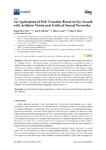An Application of Fish Detection Based on Eye Search with Artificial Vision and Artificial Neural Networks

Use este enlace para citar
http://hdl.handle.net/2183/26998Coleccións
- Investigación (FIC) [1678]
Metadatos
Mostrar o rexistro completo do ítemTítulo
An Application of Fish Detection Based on Eye Search with Artificial Vision and Artificial Neural NetworksData
2020-10-27Cita bibliográfica
Rico-Díaz, Á. J., Rabuñal, J. R., Gestal, M., Mures, O. A., & Puertas, J. (2020). An Application of Fish Detection Based on Eye Search with Artificial Vision and Artificial Neural Networks. Water, 12(11), 3013.
Resumo
[Abstract]
A fish can be detected by means of artificial vision techniques, without human intervention or handling the fish. This work presents an application for detecting moving fish in water by artificial vision based on the detection of a fish′s eye in the image, using the Hough algorithm and a Feed-Forward network. In addition, this method of detection is combined with stereo image recording, creating a disparity map to estimate the size of the detected fish. The accuracy and precision of this approach has been tested in several assays with living fish. This technique is a non-invasive method working in real-time and it can be carried out with low cost. Furthermore, it could find application in aquariums, fish farm management and to count the number of fish which swim through a fishway. In a fish farm it is important to know how the size of the fish evolves in order to plan the feeding and when to be able to catch fish. Our methodology allows fish to be detected and their size and weight estimated as they move underwater, engaging in natural behavior.
Palabras chave
Computer-vision
Hough transformation
Artificial neural networks
Fish-size
Stereovision
Eye-detection
Hough transformation
Artificial neural networks
Fish-size
Stereovision
Eye-detection
Versión do editor
Dereitos
Atribución 4.0 España
ISSN
2073-4441






